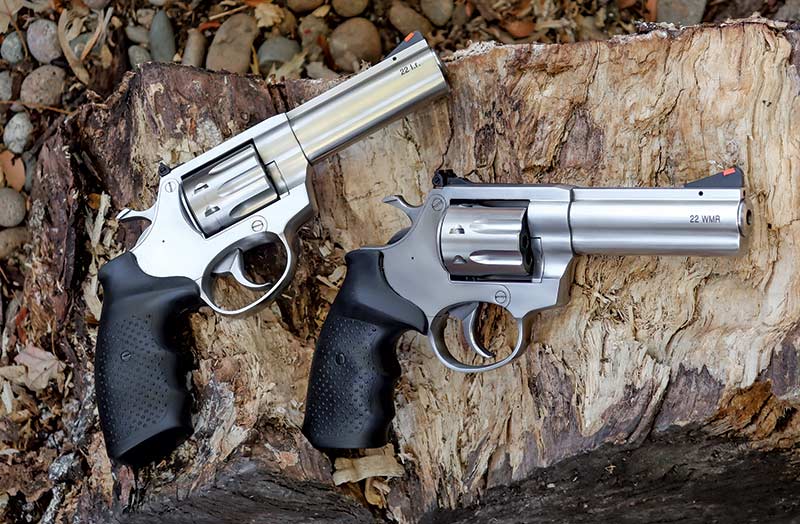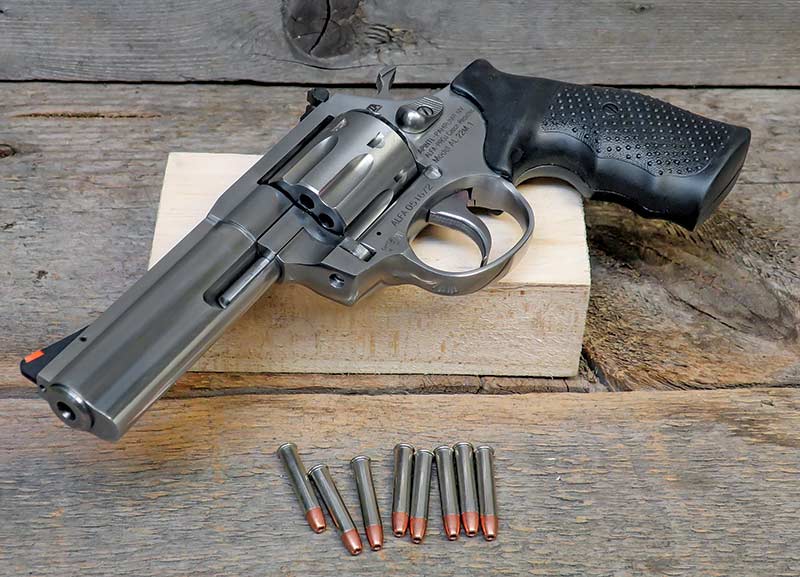Most shooters, especially if they began at a young age, started by shooting .22s. This was certainly my experience, and I also carried it over when teaching my kids and grandkids to shoot, and if I live long enough, I’ll do the same thing with my great grandkids. I find myself at this age shooting more and more .22s and enjoying them almost as much as I did when I started shooting more than 70 years ago.
Consider all that’s happened with the introduction of new .22 pistols in the past few years. Ruger modernized their series of Mark .22 pistol to the easy takedown Mark IV, brought out the economy priced single action .22 Wrangler, a semi-automatic Model 57 chambered for the 5.7 x 28mm, and for concealed carry the easy-to-operate .22 LCP II.
From S&W we have two new .22s, the Victory semi-automatic pistol and a new heavy duty .22 Magnum sixgun, the Model 648. KelTec recently introduced semi-automatic pistols in both .22 Long Rifle and .22 Magnum. Both GLOCK and Taurus are now offering excellent semi-automatic .22 Pistols. Heritage continues to produce their line of very reasonably priced SA .22s including the new Rough Rider Rancher, featuring a 16″ barrel and rifle butt stock.
And this brings us to the .22 test guns at hand from Armscor Precision International/Rock Island Armory.
LR and Magnum Twins
New for 2020, Rock Island Armory is importing a new line of revolvers. Available in stainless steel and blue finishes, RIA is offering .22 LR and .22 Magnum versions available in barrel lengths of 3″, 4″ and 6″ with adjustable sights.
These .22 revolvers are marked with three company names: RIA for Rock Island Armory, APINTL For Armscor Precision International, and a third marking indicating manufacture in the Czech Republic. The model numbers are AL22.1 for the .22 LR and AL22M.1 for the .22 WMR.
At first glance these two revolvers are identical. Except for the chambering and caliber markings, “22 l.r.” and “22 WMR” found on the left side of the barrel below the front sight they indeed could be identical twins. The only other difference is the cylinder capacity — nine rounds for the .22 LR and eight for the .22 WMR. These are definitely not lightweight sixguns as the use of all stainless steel results in a weight of just under 39 oz. for these K-Frame-sized sixguns. The stainless steel matched with rubber grips equals a .22 suited for heavy outdoor use with no worry about weather — neither rain, snow, sleet or dark of night will hamper their use.
When I first examined these revolvers, it appeared to me they had a heavy underlug barrel. I soon found the barrel is actually a two-piece affair consisting of a barrel proper and a shroud, with the heavy underlug design enclosing and protecting the ejector rod. This is a well thought out design and I had to look carefully (actually read the manual) to discover this fact.
Read the Manual
I should have also read the manual before trying to adjust the rear sight as it would have saved a few minutes of chasing my tail. Like other European revolvers I’ve encountered, the adjustment of elevation is just the opposite of American handguns. To raise the elevation, turn the adjustment screw clockwise.
This is a very good-looking revolver. Finish of the stainless steel is nicely polished, and it is just as it should be. I should note the sights, consisting of a fully adjustable rear sight and a front sight with a red insert, are not bright stainless but rather are black and easy to see.
Handling
The grips are well designed and will fit most hands quite well. Consistent with the weather beating revolver finish, the grips are black pebble grained rubber with finger grooves and provide a secure and comfortable feeling. I found it interesting the grip screw is not one long screw going all the way through, but rather each grip panel has its own screw and is completely supported by the abbreviated grip frame. This is also an excellent idea. If you install custom wooden stocks, there’s no danger of tightening a grip screw to the point of cracking the grip panel.
These sixguns are traditional DA, meaning you can fire them simply pulling the trigger or, if for a more precise shot, by cocking the hammer first. The trigger can be advertised as “smooth” in two ways. First, the face of the trigger is smooth with no irritating grooves or checkering, and this is matched up with a smooth SA pull, measuring 4 lbs. on my Brownells Trigger Gauge. The DA pull for each measured 12.5 lbs.
Since these revolvers are K-Frame size, I went into my accumulation of leather coming up with a home crafted thumb break design I made years ago for my Combat Magnum and a Safariland basket weave finished holster with a traditional safety strap. Both provide comfortable carry and security.
While one might consider these sixguns quite heavy, even with self-defense .22 Magnum ammunition, they are easy-to-use revolvers with virtually no recoil. Hollowpoint .22 Long Rifle ammunition should not be overlooked, especially for those who are recoil sensitive. When the .22 Long Rifle version is loaded with such cartridges as the CCI Mini-Mag +V hollow points it’s also a possibility for defensive use with no concern for recoil.
Range Performance
I always like to have at least a dozen different .22 LR ammunition choices when testing any .22 as they can be extremely picky. The test targets that came with each of these .22 revolvers showed 1.5″ groups at 15 meters, so I used the same distance to find ammunition that shot as well or better than exhibited by the test groups.
I put 18 different factory rounds to the test and the following, with their muzzle velocities, all grouped just right over 1″ at 15 meters. CCI Mini-Mag HP, 1,157 fps; CCI Standard Velocity, 904 fps; American Eagle HP, 1,082 fps; Remington Thunderbolt, 1,022 fps; Remington Sub-Sonic, 856 fps; and the two most accurate loads (both shooting under 1″), the CCI Green Tag at 943 fps and Winchester’s 525-round bulk pack HP at 1,083 fps.
Switching to the .22 WMR sixgun, I fired eight factory loads. The first results were very disappointing, however the more I shot the tighter the groups became. I was never able to get good results with Remington 33 AccuTips or CCI Maxi-Mag standard or hollowpoint versions. However, the CCI Speer GDHP self-defense ammunition grouped into just over 1″ with a muzzle velocity of 1,270 fps. Armscor 40-grain JHP clocks out just under 1,300 fps with a group of 11/2″ for seven shots.
With their sturdy construction there does not seem to be anything about these revolvers that would prevent them from being able to provide long-lasting service for several family generations of shooters. I doubt very much they could ever actually be worn out.






